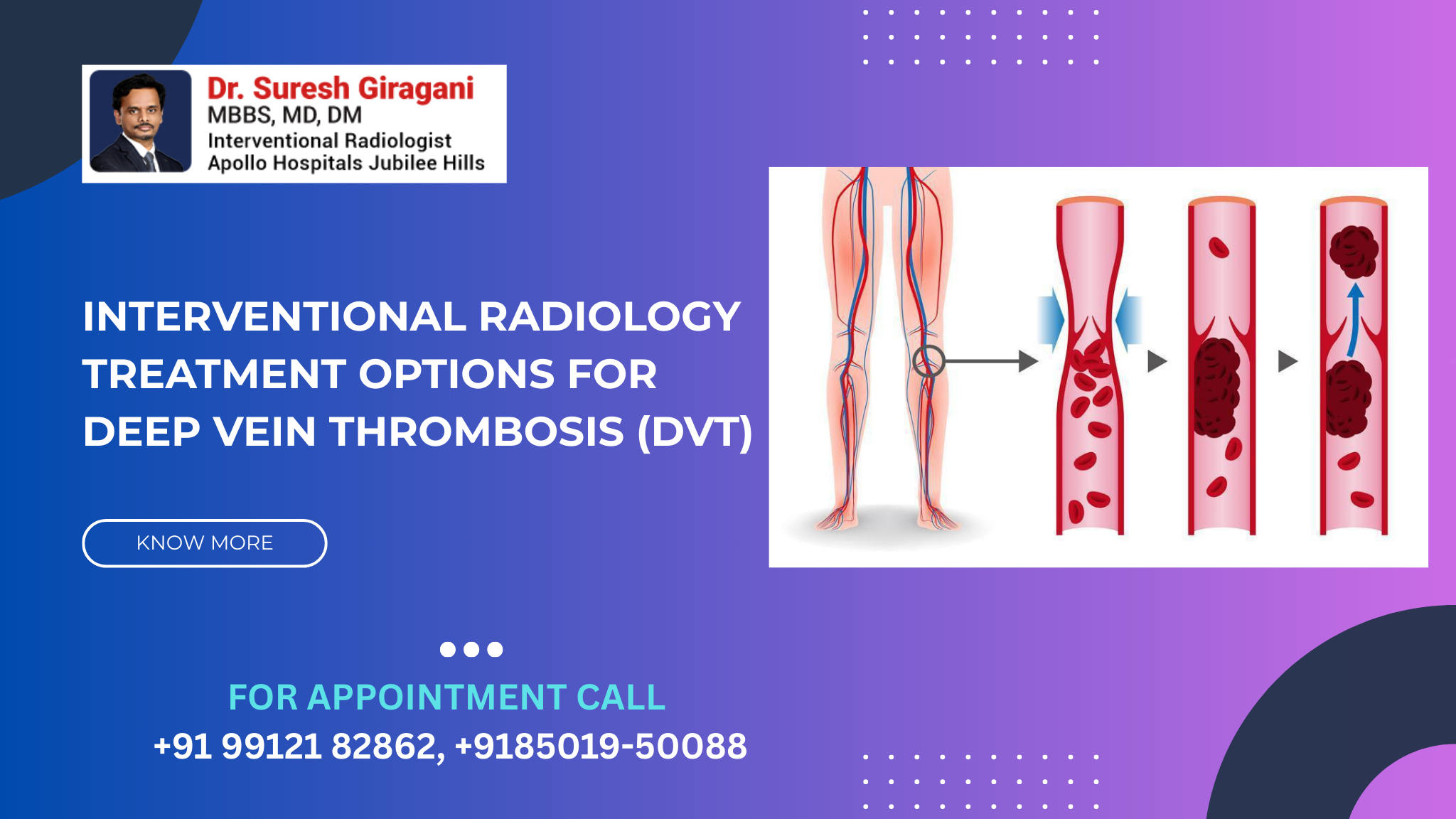
Interventional Radiology Treatment Options for Deep Vein Thrombosis (DVT)

Deep Vein Thrombosis (DVT) occurs when a blood clot forms in the deep veins, typically in the legs. If untreated, DVT can result in life-threatening complications, such as pulmonary embolism (PE), where the clot travels to the lungs. While traditional treatments for DVT include blood thinners and compression stockings, interventional radiology (IR) provides advanced, minimally invasive treatment options for managing more complex cases of DVT. These procedures can effectively remove or dissolve the clot and restore normal blood flow, reducing the risk of severe complications.
Key Interventional Radiology Treatment Options for DVT:
- Thrombectomy
- Procedure: Thrombectomy involves the removal of the blood clot from the vein. This is often performed when the clot is large or poses a significant risk of traveling to the lungs. Using advanced imaging guidance, an interventional radiologist inserts a catheter through a small incision to access the clot. Specialized tools are then used to either extract the clot or apply suction to remove it.
- Use: Thrombectomy is especially effective in cases of severe DVT, where medications are not sufficient.
- Catheter-Directed Thrombolysis (CDT)
- Procedure: CDT involves the direct delivery of clot-dissolving medications (thrombolytics) to the clot site via a catheter. This method allows the medication to target the clot more effectively and break it down over time. In some cases, mechanical devices may be combined with thrombolytics to speed up clot removal.
- Use: CDT is often preferred for patients with extensive DVT or those who are not suitable candidates for surgery.
- Endovenous Laser Therapy (EVLT) for Post-Thrombotic Syndrome
- Procedure: EVLT is used to treat veins damaged by DVT and alleviate symptoms of post-thrombotic syndrome (PTS), such as chronic pain, swelling, and skin changes. A laser fiber is inserted into the affected vein, and the vein is sealed with heat, restoring normal blood flow.
- Use: EVLT is effective for reducing the symptoms of PTS and improving quality of life for patients with long-term DVT damage.
- Inferior Vena Cava (IVC) Filter Placement
- Procedure: An IVC filter is a small device placed in the inferior vena cava to catch any blood clots that might break loose and travel to the lungs, preventing pulmonary embolism. The procedure is minimally invasive and typically performed under local anesthesia.
- Use: IVC filters are commonly used in patients who cannot take blood-thinning medications or are at high risk of pulmonary embolism.
- Stenting and Angioplasty for Venous Obstruction
- Procedure: If DVT causes long-term damage to veins, interventional radiologists may use stents (mesh tubes) to prop open narrowed veins and restore blood flow. Angioplasty, involving the inflation of a balloon catheter to open the obstructed vein, can also be used.
- Use: These procedures are helpful in restoring circulation and preventing future complications, especially in cases of venous obstruction following DVT.
- Ultrasound-Guided Sclerotherapy
- Procedure: In chronic DVT cases, ultrasound-guided sclerotherapy may be used to treat veins by injecting a sclerosing solution that causes the vein to close off and redirect blood flow through healthier veins.
- Use: This treatment is particularly effective for managing symptoms of post-thrombotic syndrome and for patients with chronic DVT.
Benefits of Interventional Radiology for DVT:
- Minimally Invasive: Most of these treatments are performed using small incisions or no incisions at all, leading to less pain, fewer complications, and faster recovery times.
- Targeted Treatment: Advanced imaging technology allows interventional radiologists to precisely target the clot or damaged vein, minimizing harm to surrounding tissues.
- Reduced Hospital Stay: Many IR procedures are outpatient, meaning patients can return home the same day and recover more quickly than with traditional surgery.
- Effectiveness: IR treatments have been shown to be highly effective in removing clots, restoring blood flow, and preventing complications like pulmonary embolism and post-thrombotic syndrome.
The Importance of Early Detection in Deep Vein Thrombosis (DVT):
Early detection of DVT is crucial in preventing serious complications like pulmonary embolism and chronic venous insufficiency. While DVT may not always cause noticeable symptoms, recognizing the signs early and seeking treatment can significantly improve outcomes. Symptoms of DVT include swelling, pain, redness, warmth, and bulging veins in the affected leg. If you experience these symptoms, it’s essential to seek medical attention promptly.
Dr. Suresh Giragani, a leading expert in vascular and interventional treatments, can help evaluate and provide treatment options tailored to your needs, ensuring the best care for DVT prevention and management.
Conclusion:
Interventional radiology offers advanced and minimally invasive treatment options for Deep Vein Thrombosis DVT, providing effective solutions for clot removal and clot dissolution, and addressing long-term complications like post-thrombotic syndrome. If you are at risk for or have been diagnosed with DVT, consulting with an experienced interventional radiologist can help you find the best treatment tailored to your needs. With early intervention and advanced treatments, you can reduce the risk of serious complications and improve your quality of life.
About the Author:

Name: DR . SURESH GIRAGANI
INTERVENTIONAL RADIOLOGIST
DR. SURESH GIRAGANI CONSULTANT INTERVENTIONAL RADIOLOGIST at Apollo hospitals Jubilee Hills has more than sixteen years of clinical experience in vascular interventions with a special interest in neurovascular and peripheral vascular disease interventional procedures.